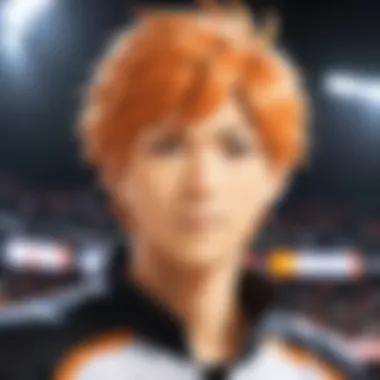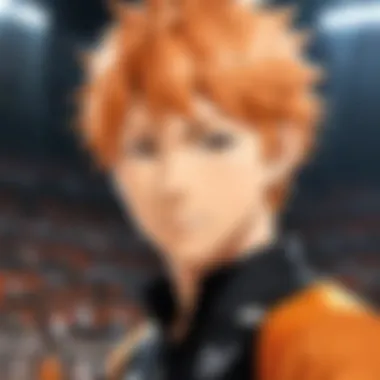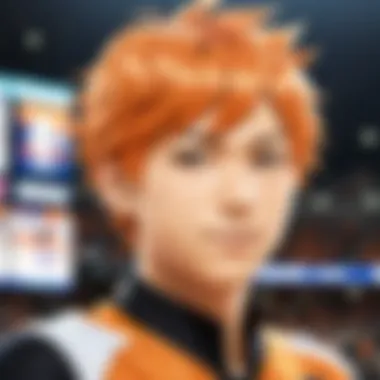Exploring Haikyuu Season 1: Insights and Implications


Intro
The world of sports anime finds its cornerstone in works like Haikyuu. With its premiere in 2014, the first season introduces viewers to the dynamic realm of high school volleyball. This article aims to dissect the qualities that set Haikyuu apart in the sports genre. It emphasizes teamwork, ambition, and resilience, which resonate widely with audiences, making them reflect on their own experiences.
In this exploration, key episodes and character arcs will be analyzed. The production quality, particularly the animation style and direction, will also be scrutinized to understand their role in shaping the series' narrative. Ultimately, this guide seeks to illuminate the deeper implications behind the vibrant matches and character interactions that make Haikyuu a significant contribution to both anime as entertainment and a cultural commentary.
Preamble to Haikyuu
In any discussion of modern sports anime, Haikyuu holds a pivotal position. Analyzing the first season of this series is critical to understand the narrative strategies employed and its wider cultural ramifications. The intricate blend of character development, thematic exploration, and artistic expression provides rich material for both casual viewers and critical scholars.
The significance of this introduction lies in establishing a framework for evaluating the series. By analyzing principal elements such as key characters and underlying messages, we see how Haikyuu captures the essence of sports, teamwork, and personal ambition. Such considerations help decipher why Haikyuu resonated deeply with audiences and has emerged as a noteworthy entry in its genre.
Overview of the Series
Haikyuu debuted in 2014 and swiftly gained recognition for its dynamic portrayal of high school volleyball. The story centers on Hinata Shoyo, a boy of short stature who dreams of becoming a top volleyball player. Despite his physical limitations, his passion and determination drive him to join his school's volleyball team. Opposing him is Kageyama Tobio, a skilled setter known for his superiority in the sport but burdened by a lack of teamwork. This combination of characters creates an engaging conflict central to the narrative.
Visually, the series is striking, employing vibrant animation and fluid movement mimicking the intensity of sports. The animation quality adds depth to tense matches, and the characters’ nuanced expressions convey their emotional journeys.
Popularity and Cultural Impact
Haikyuu did not merely entertain; it influenced sports culture within anime. The show's embrace of teamwork and perseverance speaks to a generation facing its own challenges. It has inspired many viewers to take up sports, particularly volleyball. Furthermore, Haikyuu highlights the importance of collaboration over individual achievement. The positive messages surrounding friendship and personal growth resonate widely.
"In volleyball, everyone plays a vital role, much like in life. Each team member contributes uniquely to the greater goal."
The cultural impact is also evident in its reach beyond Japan. Haikyuu has seen translations and adaptations in various languages, which speaks to its universal appeal. Fan communities discuss episodes on platforms like reddit.com and social media. This engagement reflects a significant connection between the series and its audience, shaping perceptions of sports anime as a dynamic genre.
Plot Summary of Season One
The plot summary of the first season of Haikyuu is crucial for understanding the series' narrative structure and character dynamics. By outlining key events, viewers gain a clearer appreciation of how individual character arcs interweave and advance throughout the season. Furthermore, the plot context sets the stage for the underlying themes of teamwork, ambition, and personal growth that resonate throughout the series.
Prelude of Key Characters
The first season introduces several central characters who greatly influence the narrative. Hinata Shoyo is the primary protagonist, characterized by his short stature and unwavering determination. He faces skepticism from his peers due to his height, yet his boundless energy and passion for volleyball propel him to defy odds.
Kageyama Tobio, on the other hand, is the talented setter of the Karasuno team. His exceptional skills often come with a sharp, uncompromising demeanor. This contrast between Hinata's spirited enthusiasm and Kageyama’s strategic approach creates an engaging dynamic that forms the backbone of their partnership.
Other notable characters include Daichi Sawamura, the team captain whose leadership and calm presence provide stability; Asahi Azumane, the ace whose struggles with self-confidence highlight personal challenges; and Yamaguchi and Tsukishima, whose interactions reflect themes of friendship and rivalry.
Main Conflicts and Challenges
The narrative establishes key conflicts that drive the story forward. Central to these is the internal struggle both Hinata and Kageyama face as they learn to work together effectively despite their contrasting styles. This friction is not merely a plot device; it underscores important themes of collaboration and the necessity of overcoming personal barriers for the greater good of the team.
Additionally, the Karasuno team must contend with external challenges, particularly in the form of rival teams. Their matches against established schools like Aoba Johsai and Nekoma highlight the competitive spirit inherent in sports, as well as the hurdles that must be overcome to achieve success.
In summary, the first season's plot summary encapsulates more than just events; it unveils the intricacies of character relationships and the tensions that drive the anime forward. These elements together create a rich narrative tapestry that not only entertains but also offers insights into teamwork and growth.
Character Development


Character development in Haikyuu plays a crucial role in engaging the audience and driving the narrative forward. Each character brings unique traits and personal challenges that contribute to the team dynamics and the overall theme of sportsmanship and growth. By focusing on well-defined character arcs, the series not only highlights individual struggles but also emphasizes themes of teamwork and personal ambition. This deep investment in characters leads viewers to connect emotionally, thus enhancing their experience.
Hinata Shoyo: The Underdog
Hinata Shoyo embodies the quintessential underdog in Haikyuu. His journey from a novice player to a key member of the Karasuno High volleyball team is a central focus throughout the season. Despite his short stature and lack of experience, Hinata's determination to become a great volleyball player is inspiring. His character is not just about overcoming physical limitations; it reflects a broader message about hard work and perseverance. Hinata’s growth is marked by crucial moments where he learns to harness his speed and agility effectively on the court. This progression does not only develop his skills but also evolves his understanding of teamwork. The viewers see him struggle, learn from his mistakes, and grow through various challenges, making his character arc compelling.
Kageyama Tobio: The Genius Setter
Kageyama Tobio serves as a foil to Hinata. He is marked as a genius setter with exceptional talent. However, Kageyama’s character is not without faults. His struggle lies in overcoming his ego and learning the importance of communication and collaboration. Initially seen as aloof and demanding, he undergoes significant development throughout the series. The tension between him and Hinata is palpable at first. However, as the season progresses, Kageyama begins to recognize that individual brilliance must serve the team. This realization becomes pivotal, transforming him into a more effective leader and teammate. Kageyama's growth is not just about honing his skills but also about fostering relationships with others on the team, which is essential for achieving success.
Supporting Characters and Their Roles
Supporting characters play an integral part in enriching the storyline and aiding character development in Haikyuu. Characters like Tsukishima Kei, Yamaguchi Tadashi, and Asahi Azumane each have their challenges that complement the main protagonists' journeys. Tsukishima’s initial cynicism contrasts with Hinata’s passion, creating opportunities for growth and understanding. Yamaguchi's loyalty and quiet strength help buoy Tsukishima, illustrating that each member supports one another’s development. Asahi’s struggles with self-doubt reflect the battle many athletes face internally, making his comeback a powerful moment in the narrative.
These characters establish a more comprehensive view of the dynamics within a sports team. The series illustrates that victories are not solely determined by talent but also by the emotional support and development of all team members. This nuanced portrayal resonates with audiences, echoing the real-life experiences of teamwork in sports and beyond, making Haikyuu not just a story about volleyball but a commentary on collaboration and personal growth.
Themes and Motifs
The exploration of themes and motifs serves as a critical backbone in understanding the narrative depth of Haikyuu. These themes influence both character development and plot progression, reflecting the complexities of human emotions and relationships. Through the lens of teamwork, resilience, and ambition, the series captures the essence of sports dynamics and broader life lessons. These elements resonate widely with viewers, encouraging introspection about their own experiences and aspirations.
Teamwork and Collaboration
Teamwork is the cornerstone of Haikyuu. It illustrates how collective effort can lead to success that is unattainable by individual endeavors alone. The series features numerous instances where the protagonists must learn to work cohesively. For example, the initial lack of coordination between Hinata and Kageyama highlights their need for improvement.
As the episodes unfold, the characters develop a deeper understanding of each other's strengths and weaknesses. The famous phrase "One for all and all for one" resonates profoundly within volleyball, showcasing how each player’s contribution reinforces the team as a whole. This theme reinforces the idea that collaboration extends beyond sports and into everyday life.
Resilience in Adversity
Resilience stands out as another pillar in the series. Characters face myriad challenges, including personal doubts and more practical obstacles like skilled opponents. Hinata's journey is particularly poignant. Despite his short stature and inexperience, he embodies the spirit of never giving up. His perseverance becomes a source of inspiration for his teammates, emphasizing that true strength lies in the ability to rise after a fall.
Haikyuu's narrative doesn't shy away from showing failure. Instead, it portrays these moments as valuable experiences that forge character. This acknowledgment of struggle reflects a realistic portrayal of sports and life. It invites viewers to embrace their own challenges as opportunities for growth and learning.
Ambition and Personal Growth
Ambition in Haikyuu fuels both individual character arcs and collective team aspirations. Each character has distinct goals that push them beyond their limits. For instance, Kageyama’s desire to become the best setter illustrates a personal journey filled with setbacks and triumphs.
The series shows that ambition must be tempered with humility and respect for others. Each character's growth is intertwined, meaning that their personal ambitions often contribute to the greater good of the team. These dynamics reveal that personal success does not exist in isolation; rather, it thrives in a supportive environment where everyone strives for improvement.
As audiences witness the unfolding journeys of their favorite characters, the narrative gently nudges them to reflect on their ambitions. It invites them to consider how their goals can align with those around them, fostering a sense of unity and purpose.
Cinematography and Animation Quality
Cinematography and animation quality greatly enhance the overall experience of any anime, including Haikyuu. The series excels in visual storytelling, which is crucial for depicting the energy and intensity of volleyball matches. The careful attention to detail in animation elevates the emotional stakes, making viewers feel connected to the characters and their journey. Moreover, effective camera angles and movements during game sequences amplify the excitement, allowing the audience to fully immerse themselves in the fast-paced action.
Artistic Style and Techniques
The artistic style in Haikyuu is both distinctive and effective. The character designs are well-crafted, allowing viewers to easily identify individual traits and personalities. This clarity is important as it aids in character recognition, which is essential during complex match scenes. The colors used are vibrant, reflecting the dynamic nature of the sport. Furthermore, the smoothness of animation during critical moments, such as spikes or blocks, shows the careful planning done by the animation team.


One prominent technique is the use of dynamic angles. In many scenes, the camera feels like it captures the perspective of the characters themselves. This perspective enhances the viewer's engagement. Additionally, the blending of 2D animation with 3D elements during volleyball sequences helps to provide depth and realism to the actions taking place on the court. The combination of these artistic choices results in a visually appealing product that captures the essence of volleyball.
Impact of Animation on Storytelling
Animation in Haikyuu serves as a crucial storytelling device. The fluid motions and exaggerated poses not only entertain but also convey a character's strengths, weaknesses, and emotions. During high-pressure moments, the animation style shifts to reflect the urgency and thrill, engaging the audience more than static images could.
For instance, during pivotal matches, the emphasis on close-ups of characters' faces, alongside dramatic shifts in background colors, helps to convey their inner thoughts and feelings. This technique underscores the psychological aspect of sports, emphasizing not just physical prowess but emotional resilience.
"The animation in Haikyuu is not merely a visual enhancer; it transforms moments of tension into compelling storytelling."
In summary, the cinematography and animation quality in Haikyuu Season 1 are not just technical achievements but are interwoven into the narrative itself. The choices made by the creators lend significant weight to the themes of teamwork and individual ambition, ultimately elevating the series to a standout in the sports anime genre.
Sound Design and Music
The sound design and music of Haikyuu Season 1 provide a critical layer to the overall narrative and emotional depth of the series. This aspect of production enriches the audience's experience, forming an essential part of the story's atmosphere. Sound effects, background scores, and thematic songs are strategically integrated to enhance pivotal moments. The right sound can amplify suspense, joy, or tension, thus making it vital for audience engagement.
Score and Its Role in Atmosphere
The musical score in Haikyuu is distinctively crafted, transcending simple background noise. The music varies significantly depending on the context, which allows it to effectively highlight the emotions of the characters as they face their trials on the volleyball court.
For instance, during intense match sequences, the high-energy beats propel the action forward, creating a sense of urgency. This contrasts sharply with softer, reflective compositions that accompany character development scenes, allowing viewers to absorb the subtleties of their journeys.
- The songs include orchestral elements that provide grandeur to pivotal moments.
- Electronic music often underscores themes of competition and rivalry.
These stylistic choices enhance the storytelling, drawing the audience deeper into the Haikyuu world.
Opening and Ending Themes: Analysis
The decision behind the opening and ending themes of Haikyuu plays a significant role in its storytelling strategy. The opening theme, “Imagination,” performed by SPYAIR, presents a vibrant introduction that encapsulates the spirit of the series. Its lively tempo and motivating lyrics resonate with the show's themes of aspirations and teamwork. This upbeat song energizes the viewer right from the start, framing the narrative as not just a sports story, but also a tale of personal ambition.
In contrast, the ending theme, “Tenchi Gaeshi,” offers a more reflective tone. It invites viewers to consider the emotional aspects of victory and defeat. Its slower pace reassures the audience after an intense episode, allowing a moment to reflect on the lessons learned. This dichotomy in themes states a clear message about the balance of competition and personal growth in sports.
Both themes together set a rhythm for the viewing experience, establishing expectations for each episode.
In summary, sound design and music in Haikyuu Season 1 are meticulously engineered to create an immersive atmosphere. The score and themes are not just filler; they serve as integral components that enhance the storytelling by deepening emotional impact, cultivating viewer connection, and reinforcing the series' central themes.
Comparative Analysis
In the study of media, comparative analysis plays a crucial role in understanding both content and context. It allows viewers to discern the unique and shared characteristics of various works. With respect to Haikyuu, this examination provides valuable insights into its position within the sports anime genre. By comparing Haikyuu to other series, one can better appreciate its innovations and thematic depth. Moreover, this approach helps to recognize common tropes in sports narratives and how Haikyuu either conforms to or challenges these conventions.
Haikyuu vs. Other Sports Animes
Haikyuu stands out against other sports anime such as Kuroko's Basketball and Free!. While these series share similar themes of competition and growth, Haikyuu distinguishes itself through its emphasis on teamwork over individual prowess. The narrative continuously redirects the audience's focus to the synergy that exists among team members rather than showcasing a single athlete's journey. Furthermore, the character arcs are richly developed, making each member of the Karasuno High School volleyball team feel integral to the story's progress.
When looking at art style and animation, Haikyuu employs fluid motion and dynamic angles that not only enhance the excitement during matches but also create a sense of realism. This is distinct from other series that might rely on over-exaggerated actions or less realistic portrayals of sports mechanics.
Additionally, compared to shows like Yuri on Ice, which primarily explores athletics in a personal emotional context, Haikyuu maintains a broader focus. It encapsulates the collective struggle of a team that confronts both internal and external challenges while still nurturing individual growth within that framework.


Influences from Real-Life Sports
The authenticity of Haikyuu is undoubtedly influenced by real-life sports mechanics and the physiological demands of volleyball. The creators conducted extensive research to accurately represent the gameplay and strategies involved in the sport. This is evident in the detailed animation of player movements and the choreography of their skills on the court.
Moreover, the series incorporates actual techniques used in professional volleyball, such as specific formations and plays. This inclusion not only educates viewers but also enriches the viewing experience. For fans unfamiliar with the sport, the series serves as an informative medium, clearly demonstrating the dynamics of teamwork, communication, and strategy.
Real-life figures from volleyball often inspire characterizations, such as Hinata’s speed and Kageyama’s precision, which mirror the skills exhibited by professional athletes. This lends a layer of credibility that conventional stereotypes often lack in similar genres, thus making Haikyuu a compelling narrative that resonates with sports enthusiasts and casual viewers alike.
Viewer Reception and Critique
Understanding viewer reception and critique is vital when analyzing a series like Haikyuu. This section delves into how the audience and critics responded to the first season, shedding light on both its strengths and areas for improvement. The evaluation encompasses critical acclaim and audience feedback, as well as the demographics of viewers who engaged with the show. Such insights reveal not only the success of the series in captivating its target audience but also the broader implications for the sports anime genre.
Critical Acclaim and Audience Feedback
Haikyuu received a generally positive response from both critics and fans alike. The animation quality, character development, and emotional depth of the narrative were frequently highlighted in reviews. Many praised the authentic depiction of volleyball and the attention to detail in the sports scenes. Critics noted that the show managed to balance intense sports action with the growth of characters, creating a compelling narrative.
Fans often expressed appreciation on platforms such as Reddit and various forums, discussing their attachment to characters like Hinata and Kageyama. The delivery of each match was engaging, leading to discussions about strategies and teamwork. The series also sparked conversations about real-life volleyball dynamics, contributing to its analysis within the sports anime community.
Importantly, viewer feedback often emphasized the realistic portrayal of teamwork, a theme central to the plot. This focus resonated with audiences, especially in a landscape where many sports animes leaned toward more fantastical or exaggerated portrayals of competition.
Comparative Demographics of Viewers
Analyzing the demographics of Haikyuu's audience provides important insights into its reception. The show attracted a diverse viewership, with fans ranging from teenagers to adults. Notably, many viewers are young adults, often in their twenties to thirties. This demographic shift aligns with the anime industry's growth and the increasing popularity of sports-themed narratives.
- Key demographics:
- Males and females equally engaging with the series.
- A considerable portion of audience members are involved in sports, increasing relatability.
- International appeal extends beyond Japan, attracting viewers from various cultural backgrounds.
Social media platforms like Facebook and Twitter were instrumental in spreading awareness, with clips and highlights shared widely. This organic promotion contributed to the growing fandom, leading to various discussions and collective viewing experiences. Overall, demographic analysis suggests that Haikyuu has successfully crossed cultural barriers, appealing to a wide range of viewers with its relatable storylines and universal themes of perseverance and teamwork.
"The portrayal of sports in Haikyuu brings an unexpected depth, making it distinct in a crowded genre."
End and Future Implications
The conclusion of the analysis of Haikyuu's first season draws significant insights regarding its impact on anime culture and its fans. The themes of teamwork, ambition, and resilience resonate profoundly. The careful development of characters and their struggles offers a relatable journey for viewers. Moreover, Haikyuu does not just entertain; it provides a platform for dialogue about personal growth, dedication, and the importance of collaboration.
Legacy of Haikyuu in Anime Culture
Haikyuu has left an indelible mark on the sports anime landscape. Released in a time when sports-centric narratives were becoming increasingly popular, Haikyuu stood out for its commitment to realism and character depth. The series highlights the intensity of high school sports while also emphasizing the emotional and psychological challenges players face.
The chemistry between characters such as Hinata and Kageyama offers more than just entertainment; it marks a shift in how sports anime portray relationships within teams. Their rivalry and gradual friendship encapsulate real human emotions, making the show relatable for a broad audience. Additionally, the influence of Haikyuu can be seen in newer series that strive to emulate its combination of spectacular animation and thoughtfully crafted stories.
While some shows focus on individual prowess, Haikyuu remains rooted in the idea that success comes through collective effort. This underscores the principle that collaboration, rather than isolated talent, is fundamental in achieving greatness.
Anticipation of Subsequent Seasons
As viewers reflect on the success of the first season, attention turns toward the future. The anticipation surrounding subsequent seasons of Haikyuu is palpable. Fans are eager to see how the storyline unfolds, especially with ongoing character development and new arcs introduced.
The growth from season to season is critical, given that each character continues to face new challenges. Will Hinata finally reach his goal? How will teamwork evolve among established relationships and new team members? These unanswered questions keep the audience engaged and invested in the series.
Furthermore, with each campaign, the dynamics of high school volleyball present fresh opportunities for storytelling. This allows not only the exploration of themes already established but also introduces new motifs that enhance the narrative.
In closing, the reflections on Haikyuu's first season emphasize its significance in shaping the anime landscape. The exploration of vital themes, the vibrant character arcs, and the promise of future challenges ensure that Haikyuu remains a critical point of discussion within the anime community and beyond.







